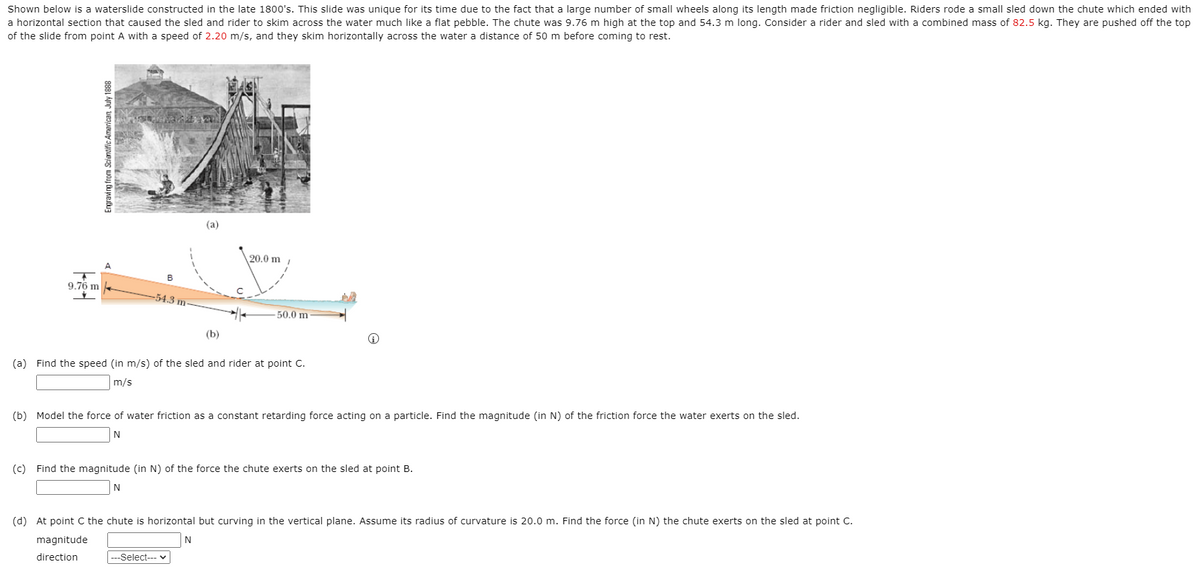Shown below is a waterslide constructed in the late 1800's. This slide was unique for its time due to the fact that a large number of small wheels along its length made friction negligible. Riders rode a small sled down the chute which ended with a horizontal section that caused the sled and rider to skim across the water much like a flat pebble. The chute was 9.76 m high at the top and 54.3 m long. Consider a rider and sled with a combined mass of 82.5 kg. They are pushed off the top of the slide from point A with a speed of 2.20 m/s, and they skim horizontally across the water a distance of 50 m before coming to rest. (a) 20.0 m 9.76 m -54.3 50.0 m (b) (a) Find the speed (in m/s) of the sled and rider at point C. m/s (b) Model the force of water friction as a constant retarding force acting on a particle. Find magnitude (in N) of the friction force the water exerts on the sled. (c) Find the magnitude (in N) of the force the chute exerts on the sled at point B.
Shown below is a waterslide constructed in the late 1800's. This slide was unique for its time due to the fact that a large number of small wheels along its length made friction negligible. Riders rode a small sled down the chute which ended with a horizontal section that caused the sled and rider to skim across the water much like a flat pebble. The chute was 9.76 m high at the top and 54.3 m long. Consider a rider and sled with a combined mass of 82.5 kg. They are pushed off the top of the slide from point A with a speed of 2.20 m/s, and they skim horizontally across the water a distance of 50 m before coming to rest. (a) 20.0 m 9.76 m -54.3 50.0 m (b) (a) Find the speed (in m/s) of the sled and rider at point C. m/s (b) Model the force of water friction as a constant retarding force acting on a particle. Find magnitude (in N) of the friction force the water exerts on the sled. (c) Find the magnitude (in N) of the force the chute exerts on the sled at point B.
Elements Of Electromagnetics
7th Edition
ISBN:9780190698614
Author:Sadiku, Matthew N. O.
Publisher:Sadiku, Matthew N. O.
ChapterMA: Math Assessment
Section: Chapter Questions
Problem 1.1MA
Related questions
Question

Transcribed Image Text:Shown below is a waterslide constructed in the late 1800's. This slide was unique for its time due to the fact that a large number of small wheels along its length made friction negligible. Riders rode a small sled down the chute which ended with
a horizontal section that caused the sled and rider to skim across the water much like a flat pebble. The chute was 9.76 m high at the top and 54.3 m long. Consider a rider and sled with a combined mass of 82.5 kg. They are pushed off the top
of the slide from point A with a speed of 2.20 m/s, and they skim horizontally across the water a distance of 50 m before coming to rest.
(a)
20.0 m
B
9.76 m
-54.3 m
50.0 m
(b)
(a) Find the speed (in m/s) of the sled and rider at point C.
m/s
(b) Model the force of water friction as a constant retarding force acting on a particle. Find the magnitude (in N) of the friction force the water exerts on the sled.
(c) Find the magnitude (in N) of the force the chute exerts on the sled at point B.
(d) At point C the chute is horizontal but curving in the vertical plane. Assume its radius of curvature is 20.0 m. Find the force (in N) the chute exerts on the sled at point C.
magnitude
direction
--Select--- v
Engraving from Sciantific American July 1888
Expert Solution
Step 1
As it is not mentioned that which three parts of the question need to be solved, please find the solutions of first three parts. Please reupload the question for the rest of the parts.
Given:
The height of the chute is 9.76 m. The length is 54.3 m.
Mass of the rider and sled is 82.5 kg.
Speed is 2.2 m/s.
The skim distance is 50 m.
Trending now
This is a popular solution!
Step by step
Solved in 3 steps with 1 images

Knowledge Booster
Learn more about
Need a deep-dive on the concept behind this application? Look no further. Learn more about this topic, mechanical-engineering and related others by exploring similar questions and additional content below.Recommended textbooks for you

Elements Of Electromagnetics
Mechanical Engineering
ISBN:
9780190698614
Author:
Sadiku, Matthew N. O.
Publisher:
Oxford University Press

Mechanics of Materials (10th Edition)
Mechanical Engineering
ISBN:
9780134319650
Author:
Russell C. Hibbeler
Publisher:
PEARSON

Thermodynamics: An Engineering Approach
Mechanical Engineering
ISBN:
9781259822674
Author:
Yunus A. Cengel Dr., Michael A. Boles
Publisher:
McGraw-Hill Education

Elements Of Electromagnetics
Mechanical Engineering
ISBN:
9780190698614
Author:
Sadiku, Matthew N. O.
Publisher:
Oxford University Press

Mechanics of Materials (10th Edition)
Mechanical Engineering
ISBN:
9780134319650
Author:
Russell C. Hibbeler
Publisher:
PEARSON

Thermodynamics: An Engineering Approach
Mechanical Engineering
ISBN:
9781259822674
Author:
Yunus A. Cengel Dr., Michael A. Boles
Publisher:
McGraw-Hill Education

Control Systems Engineering
Mechanical Engineering
ISBN:
9781118170519
Author:
Norman S. Nise
Publisher:
WILEY

Mechanics of Materials (MindTap Course List)
Mechanical Engineering
ISBN:
9781337093347
Author:
Barry J. Goodno, James M. Gere
Publisher:
Cengage Learning

Engineering Mechanics: Statics
Mechanical Engineering
ISBN:
9781118807330
Author:
James L. Meriam, L. G. Kraige, J. N. Bolton
Publisher:
WILEY